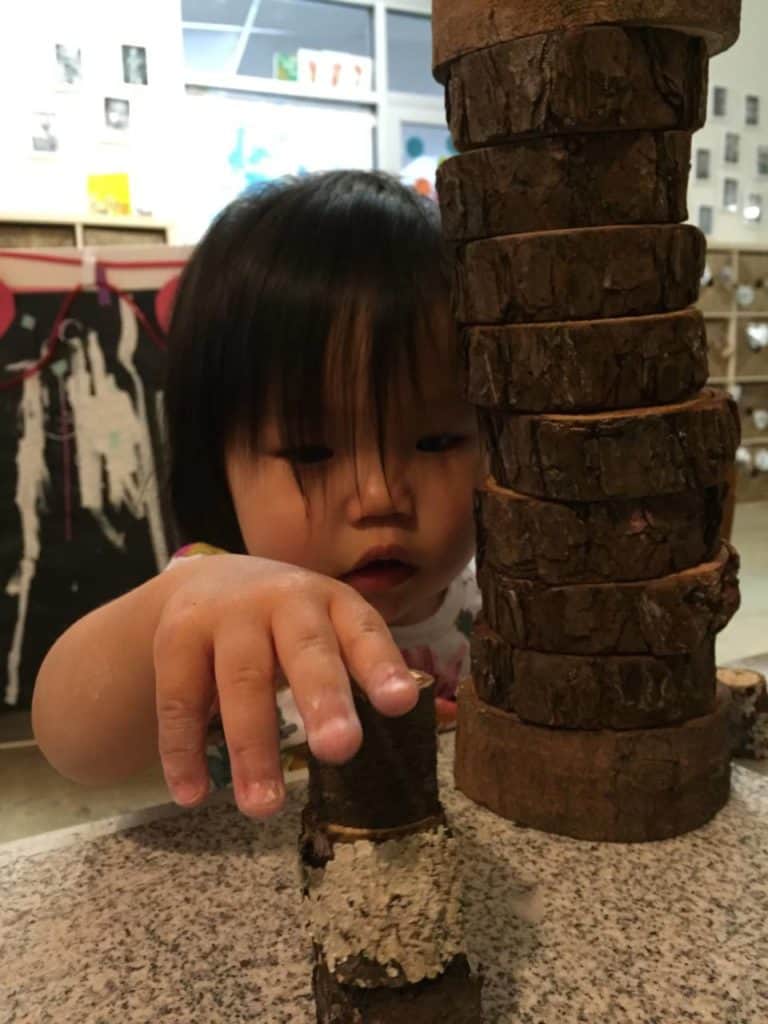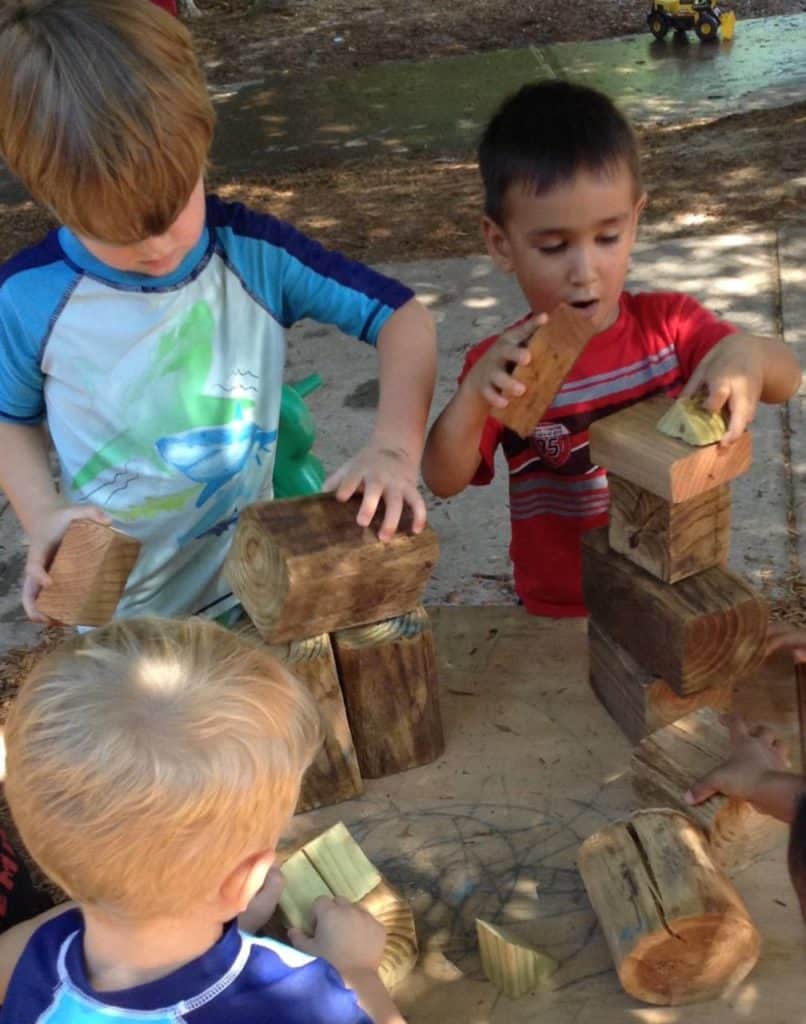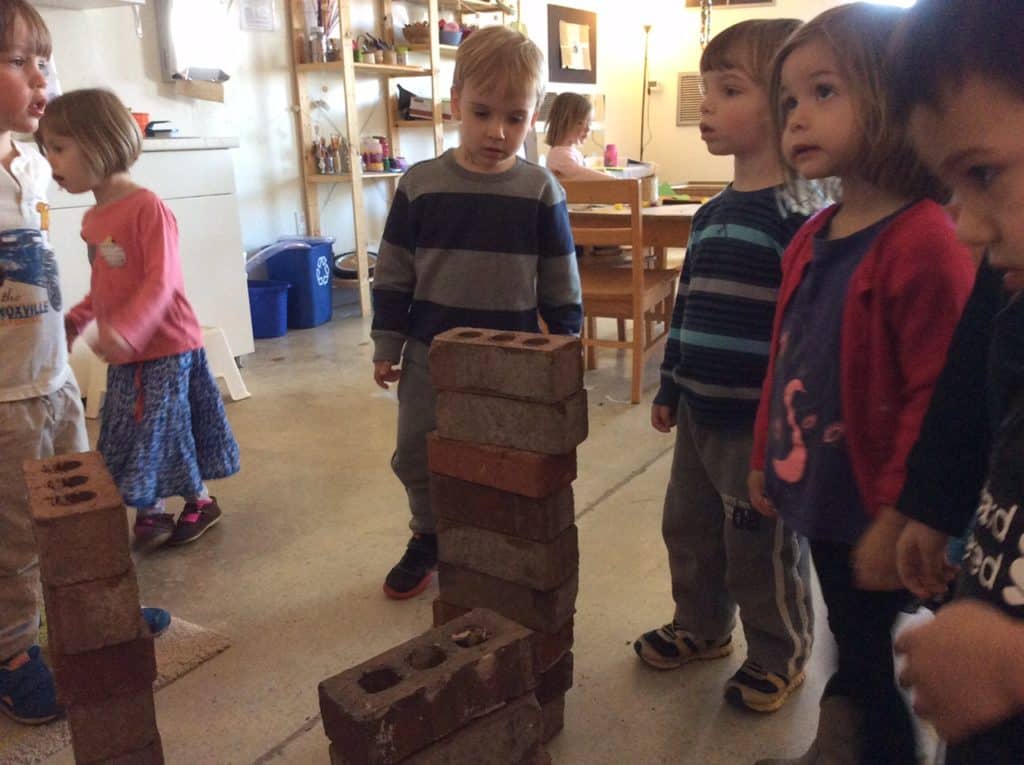In a post a few months back, the idea of “the hundred languages” was explored through a look into the evolution and emergence of letter writing. From Adelynne’s desire to be read to in the infant room to Harper’s creative spelling of words to accompany her clay sculptures, the steps throughout these early years became visible.
With that same eye on the progression across age, let’s explore another of the hundred languages. Let’s construct an image of how building progresses from our littlest hands to our tallest towers.
What do these steps tell us about how our children learn to build?
Infants and Early Ones Classroom
With our youngest children, the most basic skills and interest in constructing begin to emerge. A child might start by tasting a block, then tossing a block, then placing a block, and finally the difficult task of delicately placing a block atop another will occur … only to be knocked down with a giggle and a smile. The building has begun.

 Fin examines the qualities of the blocks, holding one in each hand and attempting to connect them in his grasp. He moves them to the ground and places one atop another, then a third stands atop the precarious tower.
Fin examines the qualities of the blocks, holding one in each hand and attempting to connect them in his grasp. He moves them to the ground and places one atop another, then a third stands atop the precarious tower.

 Benjamin works with the support of Miss Corinda. Careful focus allows his tower to grow and grow, the challenge increasing as the leaning stack gains height. Jacob’s excitement grows each time he pulls his hand away and the blocks remain standing.
Benjamin works with the support of Miss Corinda. Careful focus allows his tower to grow and grow, the challenge increasing as the leaning stack gains height. Jacob’s excitement grows each time he pulls his hand away and the blocks remain standing.
Toddlers Classroom
As fine motor skills progress into the child’s second year, buildings get taller and the materials available get bigger. The innate pleasure of knocking things down grows too, but it only offers a new opportunity to create.



Without hesitating, Ella picks wood slices one at a time, stacking them on top of each other. The tower grows and grows, reaching overhead. Ella stretches her arm into the air, placing the final piece on top. She looks around for more large slices, but after only finding small pieces she decides to use them to start the whole process again.
Twos Classroom
As children round the corner into their twos and early threes, building begins to take huge step toward intention and expression. Fine motor skills allow buildings to get taller and more detailed, budding imagination allows children to create specific constructions that emerge from their minds, and language development affords the ability to communicate stories and intentions that underlie their work. The act of stacking truly becomes the act of building.

As sharing and associative play skills develop, building becomes a group activity as well. When a teacher starts putting a few building blocks on an outdoor table, a child asks
“Can I build, too?”
A group gathers and begins passing pieces to one and other, discussing the shapes and purpose each piece serves on the new building.



“The pointy things are for helicopters!”
“They go on top!”
As children walk by, the builders announce,
“It’s Atlanta!”





What starts as small row of magnetiles, becomes a long winding fence for animals. Garrison leads the construction of the fence, protecting it from being knocked down and directing other children where to build. Such a delicate structure with so many children involved creates a social learning moment as building ideas disagree and pieces are knocked down.
Preschool Classroom
From the strong threads emerging from the children’s interest in play performance and the Westin hotel, building became an outlet for further expression and exploration. Time and time again, the children’s creations intermingle with their classroom projects.


After a visit to the Westin hotel (which could be faintly seen from the classroom window), the children began building a number of tall hotels. This group construction is only a sample of the many hotels that emerged from the block area.



The process of building is not always about the structure, sometimes the focus changes to the materials. While creating a scene setting for their outdoor rendition of “The Three Little Pigs,” the classroom explores real bricks. The weight and texture of the material adds a new dynamic to the building process.
Pre-K Classroom
In Pre-K, building begins to encompass a wide variety of other skills and interests, blending deeply with imagination, story telling, design, problem solving, and social dynamics. Something that starts as a block building, can be the catalyst for entire story lines and discussions.

A friend invites Harper on the submarine he had built, but only if she would act like a human and not a pet. Unhappy with this regulation, she solves the problem by deciding to make a submarine of her own which houses only “girls and pets.” The girls’ half of the submarine houses the girls in “churches,” while the pets’ half is comprised of “habitats.” A scene for building transformed into an opportunity to practice social problem solving.

Taking shade from a sunny afternoon, Keoki works with the outdoor materials in a quiet corner of the playground. His construction made from natural materials and blocks features stairs made of wood slices that lead toward a tower with a helicopter on top.

“You walk up the stairs here and then you jump to the top. This is the helicopter and you control it from here (pointing to the rock).”
———————————————————————————–
What can you build?
What materials will you use?
How will we interact with our peers throughout this process?
How will our imagination guide our construction?
What other “languages” can we use in or emerge from our building?
It wouldn’t take long to recognize that building and constructing is one of the favorite of the hundred languages amongst the Willow children. From the first grasp of a block to the construction of incredibly intricate and imaginative structures, the journey and growth of 3D expression is closely intertwined with our developing motor, cognitive, creative and social skills. When a wide array of materials and opportunities for building are present, the possibilities for creation are endless.